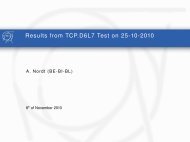A new 2 stage collimation design with new “L” shaped collimators.
A new 2 stage collimation design with new “L” shaped collimators.
A new 2 stage collimation design with new “L” shaped collimators.
You also want an ePaper? Increase the reach of your titles
YUMPU automatically turns print PDFs into web optimized ePapers that Google loves.
Fermilab Tevatron Collimator<br />
FNAL-Tevatron<br />
Experience<br />
Dean Still<br />
April 14, 2005<br />
Fermilab – Tevatron Department<br />
Cern 2005
Tevatron Collimator Experience<br />
• Introduction:<br />
– Tevatron Machine Parameters<br />
– Overview Tevatron Collimator System<br />
• Halo Removal Performance<br />
• Protecting Against Abort Kicker Prefires<br />
• Collimators , Quenching and Damage<br />
FNAL-Tevatron<br />
Cern 2005
Tevatron Machine Parameters<br />
Injection Energy<br />
Flattop Energy<br />
Number of bunches<br />
Particles per bunch<br />
Total Beam Intensities at 150, 980<br />
Gev<br />
Orbits Types<br />
Lowbeta steps<br />
Beta *<br />
Number of IP’s<br />
Shot setup (Fill) time<br />
Store lengths<br />
FNAL-Tevatron<br />
150 Gev<br />
980 Gev<br />
36 proton & 36 antiproton<br />
220-260 E9 protons & 30-50 E9 pbars<br />
Protons 1E13 , 9E12<br />
Antiprotons 1.6 E12, 1.4E12<br />
Both beams in 1 vacuum pipe ; Beams<br />
separated by electrostatic separators<br />
15 different lattice in 25 steps<br />
1.7m and transition to 35cm<br />
2 : CDF & D0<br />
2 hours<br />
~ 30 hours<br />
Cern 2005
Tevatron Collimator Overview<br />
Motivation for Collimators for Collider II Run.<br />
• Collider I System was:<br />
– Slow motion controls.<br />
– not a 2 <strong>stage</strong> collimator system.<br />
– done completely manually and took 30 min<br />
• Collider II System desired:<br />
– A Halo Removal system only- To reduce losses at IP’s.<br />
– A <strong>new</strong> 2 <strong>stage</strong> <strong>collimation</strong> <strong>design</strong> <strong>with</strong> <strong>new</strong> <strong>“L”</strong> <strong>shaped</strong><br />
<strong>collimators</strong>.<br />
– An automated system that could be initiated by Collider<br />
Sequencer software.<br />
– Halo removal had be complete in 5 -10 min.<br />
FNAL-Tevatron<br />
Cern 2005
Tevatron Collimator for Halo Removal<br />
New System Build 4 <strong>new</strong> Targets and 12 <strong>new</strong> 1.5m Collimators<br />
for Halo Removal<br />
Amplitude<br />
yx ()<br />
1.5 1.5<br />
yminx ()<br />
ymaxx ()<br />
1<br />
0.5<br />
0<br />
0.5<br />
1<br />
Target<br />
@ ~5σ<br />
Collimator<br />
@~6σ<br />
FNAL-Tevatron<br />
2 Stage Collimator System<br />
Collimator<br />
Scattered<br />
trajectories<br />
−1.5<br />
1.5<br />
45 0 45 90 135 180 225 270 315 360 405<br />
−45 x<br />
Phase Adv. (degrees)<br />
405<br />
C0<br />
B0<br />
IR<br />
protons<br />
D0<br />
IR<br />
Proton Set 1<br />
D49 Tar, E03 & F172<br />
2nd<br />
Proton Set 2<br />
D171Tar, D173 & A0<br />
Pbar Set 1<br />
F49 Tar, F48 & D172<br />
Pbar Set 2<br />
F173 Tar, F171 & E02<br />
A0<br />
Cern 2005<br />
antiprotons<br />
target<br />
collimator<br />
E0<br />
F0
Tevatron Shot Setup Process<br />
Inject 36 final<br />
protons<br />
Open Helix &<br />
Inject 9 Trans<br />
of 4 Pbar bunches<br />
Accelerate<br />
Goto Lowbeta<br />
Remove Halo<br />
FNAL-Tevatron<br />
Cern 2005
Collimator Moving Order for Halo Removal<br />
Collimators move under 2 types of feedback:<br />
1) Loss monitor Feedback<br />
2) Beam intensity and Loss monitor feedback<br />
1 2 3<br />
4<br />
Move to Poised<br />
Position<br />
N*s<br />
FNAL-Tevatron<br />
p<br />
Fine Scrape Beam-Coll Pull back for<br />
Parallel<br />
Calibration<br />
Store<br />
p<br />
coll<br />
p<br />
Sequence in Time of Collimator movement for Halo Removal<br />
N*s<br />
p<br />
5<br />
Cern 2005<br />
Prepare for next<br />
sequence<br />
Time<br />
p
Proton & Pbar Targets moving during Halo Removal<br />
FNAL-Tevatron<br />
Proton bunched beam intensity<br />
Pbar bunched beam intensity<br />
F49 local BLM<br />
D49 local BLM<br />
BLM Stop Limit<br />
Remove .5% of proton beam<br />
Cern 2005
Collimator Controls Hardware<br />
Local Loss Monitors<br />
used for pbar losses<br />
F17<br />
Spool<br />
F171 F172<br />
Collimator Collimator<br />
FNAL-Tevatron<br />
F17<br />
Kicker<br />
Protons<br />
Local Loss Monitors<br />
used for proton losses<br />
F173<br />
Target<br />
F17<br />
Dipole<br />
VME based processor to conduct fast feedback<br />
Cern 2005
Collimator Controls Block Diagram<br />
C48<br />
Sequencer<br />
FNAL-Tevatron<br />
init<br />
abort<br />
set<br />
OAC is a Central Process<br />
that orchestrates global<br />
movement of all <strong>collimators</strong><br />
across 4 Front Ends<br />
BPM<br />
LATTICE<br />
FLYING WIRE<br />
read<br />
OAC<br />
calc xi(N,seq,ect)<br />
T:CCTLXX[NUM_COL]<br />
V:TEVCOL<br />
Coll FE(n)<br />
read/set<br />
seq map<br />
process<br />
read set V:TEVCOL<br />
coll status T:XXXenable - verify<br />
T: (mode) T:(mode) - go<br />
read state<br />
mdat<br />
tclk<br />
mcast<br />
Local Parameters[NUM_COLL]{<br />
xi [NUM_SEQ] sq<br />
xo[NUM_SEQ] NL<br />
dx[NUM_SEQ] PL<br />
dt[NUM_SEQ] Loss[NUM_SEQ]<br />
Mode[NUM_SEQ]<br />
enable[NUM_SEQ]<br />
Collimator<br />
Application<br />
read<br />
status<br />
map<br />
manual<br />
control<br />
graphics<br />
read/set<br />
coll<br />
local<br />
params<br />
Cern 2005
Tevatron Collimator Experience<br />
• Introduction:<br />
– Tevatron Machine Parameters<br />
– Overview Tevatron Collimator System<br />
• Halo Removal Performance<br />
• Protecting Against Abort Kicker Prefires<br />
• Collimators , Quenching and Damage<br />
FNAL-Tevatron<br />
Cern 2005
Halo Loss Reduction Facto<br />
100.00<br />
90.00<br />
80.00<br />
70.00<br />
60.00<br />
50.00<br />
40.00<br />
30.00<br />
20.00<br />
10.00<br />
0.00<br />
FNAL-Tevatron<br />
Halo Removal Efficiency<br />
Halo Removal Efficiency (Protons)<br />
1000 1500 2000 2500 3000 3500 4000<br />
7/2002 1/2005<br />
Store #<br />
CDF Protons D0 Protons<br />
1000.00<br />
900.00<br />
800.00<br />
700.00<br />
600.00<br />
500.00<br />
400.00<br />
300.00<br />
200.00<br />
100.00<br />
CDF Halo loss reduced ~ 10<br />
D0 Halo loss reduced ~ 1 until<br />
Vacuum and alignment improvements<br />
Halo Loss Reductio<br />
0.00<br />
Halo Removal Efficiency (Anitprotons)<br />
1000 1500 2000 2500 3000 3500 4000<br />
Store #<br />
CDF Anitprotons D0 Antiprotons<br />
CDF Halo loss reduced ~ 20<br />
D0 Halo loss reduced ~ 100<br />
Cern 2005
Halo Loss ( loss (hz)/intensity (1E9))<br />
10.00<br />
9.00<br />
8.00<br />
7.00<br />
6.00<br />
5.00<br />
4.00<br />
3.00<br />
2.00<br />
1.00<br />
0.00<br />
CDF & D0 Halo Loss vs. Store<br />
1000 1500 2000 2500 3000 3500 4000<br />
FNAL-Tevatron<br />
Store #<br />
CDF Protons CDF Anitprotons D0 Protons D0 Antiprotons<br />
Cern 2005
• Success<br />
Halo Removal Comments<br />
– New 2 <strong>stage</strong> <strong>design</strong> has proven to work <strong>with</strong><br />
good efficiency.<br />
– Automation process to Halo Removal very easy<br />
and reliable<br />
• Adapting<br />
– The Double scrape: Collimators stopping<br />
prematurely.<br />
– Alignment of Collimators; only checked 3 times<br />
a year<br />
FNAL-Tevatron<br />
Cern 2005
Halo Removal Comments- Continued<br />
• Problems<br />
– Quenching while scraping - Providing a Post-<br />
Mortem account in the Collimator Front end.<br />
– Quenching due to automating Halo Removal.<br />
Date<br />
March 2002<br />
March 2002<br />
March 2005<br />
March 2005<br />
March 2005<br />
FNAL-Tevatron<br />
Lost Store Comment<br />
Lost store at Halo removal due to mech stand failure<br />
Lost store at Halo removal due to mech stand failure<br />
Lost store at Halo removal due to D17 ahead of D49<br />
Lost store at Halo removal due to FE bug<br />
Lost store at Halo removal due to FE bug<br />
Cern 2005
Tevatron Collimator Experience<br />
• Introduction:<br />
– Tevatron Machine Parameters<br />
– Overview Tevatron Collimator System<br />
• Halo Removal Performance<br />
• Protecting Against Abort Kicker Prefires<br />
• Collimators , Quenching and Damage<br />
FNAL-Tevatron<br />
Cern 2005
History of Abort Kicker Prefires<br />
FNAL-Tevatron<br />
Prefire Collimators Not installed<br />
Collider Run I Prefires<br />
Cern 2005
Addition of A48 Collimator to Protect<br />
against A0 abort kicker prefires<br />
FNAL-Tevatron<br />
Add .5 m<br />
Collimator<br />
at A48 to shield<br />
against prefires<br />
C0<br />
B0<br />
A11V collimator<br />
Already in place<br />
IR<br />
protons<br />
D0<br />
IR<br />
A0<br />
Cern 2005<br />
antiprotons<br />
target<br />
collimator<br />
A0 proton abort<br />
kickers<br />
E0<br />
F0
A0 Kicker Transient Recorder<br />
P8 P10 P12<br />
P7 P9 P11<br />
AAK1 prefire kicks 6 bunches<br />
To To CDF.<br />
FNAL-Tevatron<br />
Antiproton Abort Kickers<br />
12 12<br />
7<br />
Bunches hitting<br />
the the A0 A0 abort block<br />
Proton Abort Kickers<br />
Cern 2005
A49 Loss Paddle for Prefire 3-8-2005<br />
CDF<br />
A49<br />
A49 Loss Paddle<br />
A48 Collimator<br />
A47<br />
Protons<br />
FNAL-Tevatron<br />
P7 P12<br />
AA marker<br />
A49 Loss Paddle<br />
A49 BPM Int.<br />
A47 BPM Int.<br />
Cern 2005<br />
P7-abort<br />
P8-Hit<br />
P9-Hit<br />
P10-Hit<br />
P11-Hit<br />
P12-Hit
A48U<br />
FNAL-Tevatron<br />
Quench Data<br />
Cell<br />
A48U<br />
F48U<br />
B15U<br />
A48L<br />
B15L<br />
F48L<br />
Line<br />
Cycle<br />
A48U is one of the fastest<br />
quenches we have had.<br />
0<br />
0<br />
2<br />
8<br />
9<br />
9<br />
Notice we did not quench A1<br />
Cern 2005
Comments on Kicker Prefire and Collimators<br />
• Tevatron did not originally <strong>design</strong> a collimator<br />
system to protect against kicker prefires.<br />
• Once the collimator was installed, it was hard to<br />
tell if the prefired beam was hitting it.<br />
• Once confident prefired beam hit the collimator,<br />
may need to increase length to protect<br />
downstream cold spool.<br />
• Need a better post-mortem system to determine<br />
where all kicked bunches went.<br />
FNAL-Tevatron<br />
Cern 2005
Tevatron Collimator Experience<br />
• Introduction:<br />
– Tevatron Machine Parameters<br />
– Overview Tevatron Collimator System<br />
• Halo Removal Performance<br />
• Protecting Against Abort Kicker Prefires<br />
• Collimators , Quenching and Damage<br />
FNAL-Tevatron<br />
Cern 2005
Collimators, Quenches and Damage<br />
• December 5, 2003<br />
– First learned of a <strong>new</strong> category of quench called a<br />
“Fast Quench”<br />
– A Roman Pot moved into beam due to a controls<br />
error causing beam loss damaging 2 <strong>collimators</strong> and<br />
2 spool pieces (3 correction elements)<br />
C18 spool E03 1.5m collimator D49 target<br />
FNAL-Tevatron<br />
Cern 2005
A48 Bus Drawing – Fast Quench<br />
Pot 3 location<br />
FNAL-Tevatron<br />
Protons<br />
A48U quenching dipoles: Looses current<br />
At .5A/msec before the abort fires<br />
Cern 2005
FNAL-Tevatron<br />
QPM Over Sample Buffer<br />
16msec<br />
Quench A48 1st Abort Fired<br />
Quenched 5 dipoles at A48; DI/Dt = .5A/msec<br />
Development of<br />
Quench:<br />
A48U 16msec<br />
D48L 13.5msec<br />
F17L 13msec<br />
E11U 12.5 msec<br />
Cern 2005<br />
Before abort<br />
(Courtesy D. Wolff<br />
& EE Support)
July 8,2004 – B11 Horizontal Separator Spark<br />
Quench Estimate of Orbit growth w/ QPM Fast Abort<br />
Fast<br />
Quench<br />
FNAL-Tevatron<br />
(mm)<br />
(mm)<br />
10<br />
10<br />
8<br />
8<br />
6<br />
6<br />
4<br />
4<br />
2<br />
2<br />
-4<br />
-4<br />
-6<br />
-6<br />
-10<br />
-10<br />
Hor orbit for F48 kick due to F4 Quench<br />
Hor orbit for F48 kick due to F4 Quench<br />
2 msec after quench<br />
2 msec after quench<br />
0<br />
0<br />
0 20 40 60 80 100 120<br />
-20<br />
20 40 60 80 100 120<br />
-2<br />
Resulting -8Orbit<br />
-8<br />
Due to fast quench<br />
Ring BPM location<br />
Ring BPM location<br />
Fast QPM abort would<br />
have stopped quenches in<br />
4 other houses<br />
Cern 2005<br />
Displacement @ # msec<br />
Displacement @ # msec<br />
real orbit<br />
real orbit<br />
diff sim-real<br />
diff sim-real
Minimum Level to<br />
Set BLM abort level<br />
BLM Plot from December 5 Quench<br />
FNAL-Tevatron<br />
Fast quench could have been detected<br />
Dipole at d4 could have pulled abort<br />
Abort Kicker fired<br />
Cern 2005<br />
1 frame=2msec
Tevatron Ring Wide Loss Plot (Dec 5)<br />
FNAL-Tevatron<br />
Cern 2005
FNAL-Tevatron<br />
Comments on Fast Quench<br />
• Tevatron masks all BLM inputs during a store<br />
due to very high probability of false abort.<br />
• Fixed the Fast Quench by QPM code; over<br />
sample and detect a large quench. Pulls abort<br />
<strong>with</strong>in 2msec instead of 16msec.<br />
• BLM upgrade is in the works to gain additional<br />
protection.<br />
• Host of mechanisms to create fast quench<br />
– Separator sparks<br />
– Motion controlled device, Vacuum values, pots,<br />
mirrors for sync light, <strong>collimators</strong><br />
Cern 2005
Comments on Fast Quench- Continued<br />
• May 15, 2004 – Unknown<br />
cause – Damaged E03<br />
collimator again<br />
• With a scan found it<br />
damaged and ran 3 months<br />
<strong>with</strong> it damaged.<br />
FNAL-Tevatron<br />
Cern 2005
FNAL-Tevatron<br />
Summary<br />
• Collider II Halo removal system has worked well as far as halo<br />
removal efficiency and automatic process.<br />
• Still working on improving collimator and post –mortem system for<br />
abort kicker prefires.<br />
• Dec 5,2003 quench and damage was “wake up call” to rethink<br />
Tevatron beam loss protection.<br />
• Learned details of <strong>new</strong> category of “fast quenches”.<br />
• Implemented <strong>new</strong> QPM code to abort on detection of quench <strong>with</strong>in<br />
1-2msec, instead of 16msec. But still mask BLM during stores due<br />
to false aborts.<br />
• Reviewed all motion controlled devices <strong>with</strong> appropriate Abort.<br />
– Vacuum abort upgrade done.<br />
– Pot motion upgrade done.<br />
• Insufficient process for gathering systematic and automatic data for<br />
analyzing past quenches involving beam loss. Working on better<br />
record keeping of data for every quench.<br />
• Provided input to <strong>new</strong> BLM system coming in 2005.<br />
Cern 2005



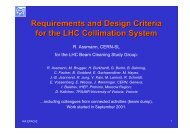
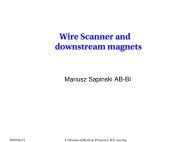
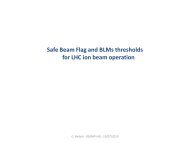
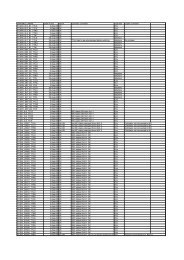
![marek.ppt [Read-Only] - LHC Collimation Working Group - Cern](https://img.yumpu.com/18209900/1/190x135/marekppt-read-only-lhc-collimation-working-group-cern.jpg?quality=85)
